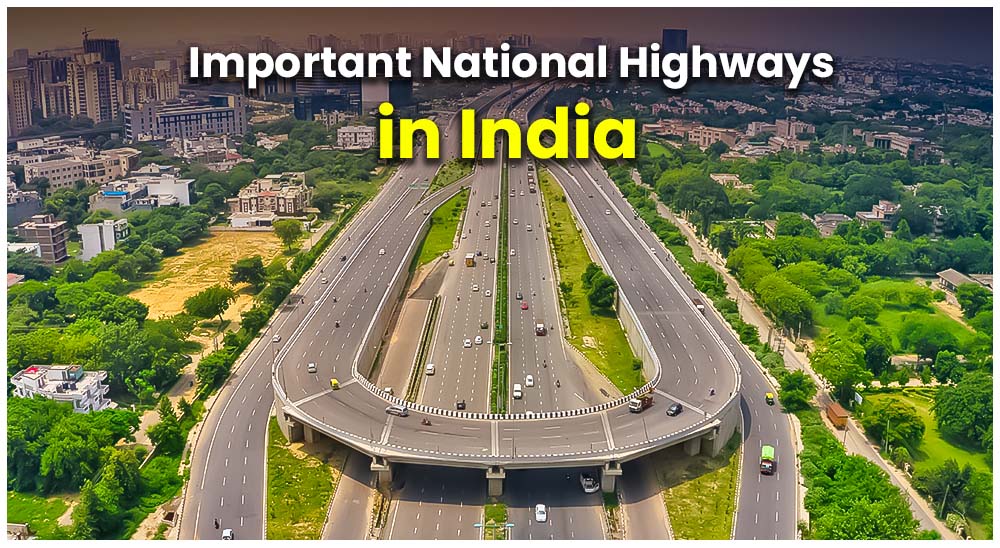National Highways – List of Total and Important National Highways in India
India has a vast network of National Highways and State highways which not only facilitates easy movement of goods and services but also boosts the economy. All of these highways are managed and organised by the National Highway Authority of India. This organisation is majorly focused on planning, developing and constructing new highways along with maintaining the older ones.
Presently, India is home to 87 highways and runs over a total length of 1,51,000 KM. In this article, we have discussed the classification and importance of the National Highway. Along with this, we have also provided the complete list of National Highways.
Classification of National Highways
The National Highways are classified into four parts, know more about the same in the section below.
- North-South Corridors
North-South Corridors are a part of the National Highway Development Project (NHDP) aimed at improving connectivity between the northern and southern regions of India. The North-South Corridors typically run vertically, connecting major cities and regions along their path. The highways are named with the prefix N and cover a length of 4000 km.
- East-West Corridors
East-West Corridors have focus on improving connectivity between the eastern and western regions of India. These corridors help streamline transportation and trade by connecting various states and cities horizontally. These run from East to West and have an odd number. The total length of the East-West Corridor is 3300 KM.
- East Coast Road (ECR)
The East Coast Road (ECR) is a scenic coastal highway that runs along the eastern coast of India, connecting Chennai in Tamil Nadu to Kanyakumari. It offers breathtaking views of the Bay of Bengal and provides access to popular tourist destinations, beaches, and towns along the coast. The total length of ECR is 777 KM and is often named SH-XX and NH etc.
- Golden Quadrilateral (GQ)
The Golden Quadrilateral forms a quadrilateral shape by connecting the four major metropolitan cities of Delhi, Mumbai, Chennai, and Kolkata. The GQ consists of high-quality four-lane (and in some sections, six-lane) highways that aim to improve connectivity and reduce travel time between these major cities. It plays a pivotal role in facilitating trade, commerce, and tourism, covering approximately 5,846 KM.
Who Develops National Highways in India?
The National Highway Authority of India was established under the NHAI Act of 1988. It works under the Ministry of Road Transport and Highways. This organisation is entrusted with different tasks like developing, maintaining, and improving India’s roadways. NHAI has a division named National Roads Development Project (NRDP) which initiative to improve, rebuild, and widen essential highways.
The National Highways Authority of India (NHAI) is an autonomous authority that maintains the National Highways at international standards, provides cost-effective services, and promotes people’s welfare. As of March 2022, the NHAI had finished the construction of approximately 1,40,995 kilometres of national roadways. National Highways make up only 2.7 per cent of India’s overall road network.
National Highways in India List
The total length of National Highways in India is 1,51,109 KM. Presently, there are 87 highways in the country that run along different states and UT thus boosting the connectivity and smooth passage. In the following table, we have prescribed the names of the National Highways in India along with the states through which it passes.
| New National Highway Number | Old National Highway Number | States and UTs through which it passes |
| NH 1 | NH 1 A and NH 1 D | Jammu & Kashmir and Ladakh |
| NH 244 | NH1 B | Jammu & Kashmir |
| NH 19 (Golden Quadrilateral) | NH 2 | Bihar, Delhi, Haryana, Jharkhand, Uttar Pradesh, West Bengal |
| NH 519 | NH 2A | Uttar Pradesh |
| NH 114 | NH 2B | West Bengal |
| NH 60 | NH 3
NH 50 |
Maharashtra |
| NH 4 | NH 223 | Andaman & Nicobar Islands |
| NH 748 | NH 4A | Goa, Karnataka |
| NH 348 | NH 4B | Maharashtra |
| NH 16 (Golden Quadrilateral) | NH 5
NH 6 NH 60 NH 217 |
Andhra Pradesh, Odisha, Tamil Nadu and West Bengal |
| NH 135 | NH 7 | Madhya Pradesh, Uttar Pradesh |
| NH 138 | NH 7 A | Tamil Nadu |
| NH 48 (Golden Quadrilateral) | NH 8 | Delhi, Gujarat, Haryana, Karnataka, Maharashtra, Rajasthan and Tamil Nadu |
| NH 41 | NH 8 A | Gujarat |
| NH 147 | NH 8 C | Gujarat |
| NH 151 | NH 8 D | Gujarat |
| NH 66 (Parallel to the Western Ghats) | NH 17
NH 47 |
Maharashtra, Goa, Karnataka, Kerala and Tamil Nadu |
| NH 65 | NH 9 | Andhra Pradesh, Maharashtra, Karnataka and Telangana |
| NH 21 | NH 11 | Rajasthan, Uttar Pradesh |
| NH 148 | NH 11 A | Rajasthan |
| NH 45 | NH 12 | Madhya Pradesh, Chattisgarh |
| NH 40 | NH 18
NH 4 |
Andhra Pradesh, Tamil Nadu |
| NH 5
NH 21 |
NH 22
NH 95 |
Haryana, Chandigarh, Himachal Pradesh and Punjab |
| NH 320 | NH 23 | Jharkhand |
| NH 530 | NH 24 | Uttar Pradesh |
| NH 319 | NH 30 | Bihar |
| NH 112 | NH 35 | West Bengal |
| NH 129 | NH 39 | Assam, Nagaland |
| NH 544 | NH 47 | Kerala, Tamil Nadu |
| NH 966 B | NH 47 A | Kerala |
| NH 966 A | NH 47 C | Kerala |
| NH 110 | NH 55 | West Bengal |
| NH 731 | NH 56 | Uttar Pradesh |
| NH 156 | NH 79 | Rajasthan |
| NH 127 A | NH 152 | Assam |
| NH 315 | NH 38 & NH 153 | Assam, Arunachal Pradesh |
Importance of National Highways
National Highways play a pivotal role in India’s economic and social development. Their importance can be summarized as follows:
- National Highways serve as critical arteries for transporting goods and people across the country. They facilitate the movement of raw materials, finished products, and agricultural produce, contributing to trade and economic activities. Efficient transportation reduces logistical costs and enhances competitiveness.
- National Highways link remote areas, towns, villages, and cities, fostering social integration and regional development. They reduce geographical barriers, making essential services, education, healthcare, and markets more accessible to rural and urban populations.
- National Highways are vital for domestic and international trade. They connect production centres to distribution hubs, ports, and borders, facilitating the movement of goods. Efficient transportation is crucial for export-import activities and cross-border trade.
- The construction and maintenance of National Highways generate employment opportunities across various sectors. The major examples of this sector include engineering, construction, maintenance, transportation, and hospitality.
- National Highways provide access to tourist destinations, and cultural sites thus promoting tourism in the country.
- National Highways are helpful to boost the industrial growth of the country by connecting industrial hubs. The major ones are Special Economic Zones (SEZs), and manufacturing clusters which bind together the economy of the country. Additionally, they also attract investments, create industrial corridors, and support infrastructure development.
FAQs
- How many important national highways are there in India?
Ans. According to the Ministry of Roads, Transport and Highways (MoRTH), there are 599 National Highways in India.
- What is the new name of NH 1?
Ans. The new name of NH 1 is Sher Shah Suri Marg.
- What is the new name of NH 47?
Ans. The new name of NH 47 is National Highway 544.
- Which is the most important national highway in India?
Ans. NH 48, NH 27, NH 30, NH 16 are the most important national highway in India.
- What is the total number of national highways and their length in India?
Ans. There are 87 national highways in India and their length is 1,51,000 KM.





